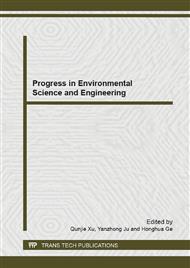p.1277
p.1281
p.1286
p.1290
p.1296
p.1300
p.1305
p.1309
p.1315
Environmental Capacity Study for Hangzhou Urban Agglomeration
Abstract:
Hangzhou urban agglomeration (HzUA) plays a decisive role in Zhejiang province and even in the Changjiang delta. Whose core is Hangzhou, the main body is Hangzhou district and Huzhou, Jiaxing, Shaoxing city is the vice center. It is an important subject to evaluate sustainability of the HzUA quantitatively.The article constructs the city ecological efficiency index (CEI) with the emergy analysis theory, analyzes quantitatively the resources supply and environmental capacity of the HzUA. The case study shows that the CEIs of the four major cities are all not high, among 0.15-0.19. Especially, the CEI of Jiaxing is the minimum, although whose renewable natural resources of unit area is the maximum. It is worth attention. To realize the HzUA steady, harmonious and healthy development, two aspects measures must be adopted, namely, adjust industrial structure and strengthen environmental protection.
Info:
Periodical:
Pages:
1296-1299
Citation:
Online since:
December 2012
Authors:
Price:
Сopyright:
© 2013 Trans Tech Publications Ltd. All Rights Reserved
Share:
Citation:


